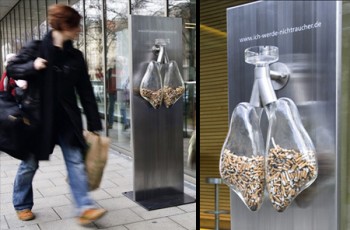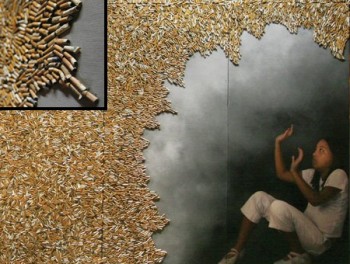Babies who sleep with smoker parents exhibit high nicotine levels
“Third-hand smoke” stuck to skin or clothing is responsible for the high nicotine levels seen in babies who share a bedroom with their smoker parents. This is the conclusion of a study carried out in Catalonia, which also shows that ventilating bedrooms is not effective in reducing the levels of toxins from passive smoking.
“Passive smoking is the leading preventable cause of childhood death in developed countries”, Guadalupe Ortega, lead author of the research study and coordinator of the Atenció Primària Sense Fum programme at the Department of Health of the Generalitat de Cataluña (Catalonia regional government) tells SINC.
The data show that babies who sleep in the same room as their parents exhibit nicotine levels three times higher than those that sleep in another room. These figures show that they suffer from what is known as “third-hand smoke”, in other words the harmful smoke particles that impregnate their parents’ skin, clothes and hair.
Known as BIBE (Brief Intervention in Babies. Effectiveness) “the study highlights exposure to tobacco smoke among this very vulnerable age group in private spaces, where no specific programmes are yet in place”, says Ortega.
The study, published in BMC Public Health, the results of which are currently being studied, involved the participation of 96 primary healthcare centres in Catalonia. The experts interviewed the parents of 1,123 babies (under 18 months of age), who had at least one smoking parent. They analysed hair samples from 252 babies in order to determine their nicotine levels, and carried out follow-up visits three and six months later.
 The parents’ statements largely coincided with the results obtained from the hair analysis – 73% of the adults said they smoked or allowed smoking in their homes, while 83% of the hair analysed showed up high nicotine levels.
The parents’ statements largely coincided with the results obtained from the hair analysis – 73% of the adults said they smoked or allowed smoking in their homes, while 83% of the hair analysed showed up high nicotine levels.
The myth of ventilation
The hair nicotine analyses also showed that smoke toxins are not eliminated even if parents regularly carry out actions to protect their children’s health. This was the case with ventilating bedrooms after smoking, smoking at the window, or when the baby is not in the house or in a different room. “The only way of keeping the place smoke-free is to smoke outside the house”, the expert stresses.
The study also shows that parents’ influence varies according to their gender. As mothers generally spend most time with babies, it is they who expose their children to the greatest levels of tobacco smoke. They were also found to breast feed for less time than non-smoking mothers.
Anti-smoking law helps children
According to the study, children are most heavily exposed to smoke in private places, such as at home and in cars, as well as in bars and cafés, where smoking was allowed in 2009 (when the fieldwork was carried out).
 “The tightening of the law to control smoking is important because of its indirect effect on raising awareness among the public at large”, the researcher explains. In her opinion, the application of this law has led to an increase in people requesting help to give up smoking.
“The tightening of the law to control smoking is important because of its indirect effect on raising awareness among the public at large”, the researcher explains. In her opinion, the application of this law has led to an increase in people requesting help to give up smoking.
The experts are now preparing a study to identify the factors that most strongly influence children’s exposure to smoke. This information will provide paediatricians with a scale to help them detect the risk of passive smoking in childhood.
###
Reference: Guadalupe Ortega, Cristina Castellà, Carlos Martín-Cantera, Jose L Ballvé, Estela Díaz, Marc Saez, Juan Lozano, Lourdes Rofes, Concepció Morera, Antònia Barceló, Carmen Cabezas, Jose A Pascual, Raúl Pérez-Ortuño, Esteve Saltó, Araceli Valverde, Mireia Jané y el grupo de estudio BIBE. “Passive smoking in babies: The BIBE study (Brief Intervention in babies. Effectiveness)”. BMC Public Health. 10. 20 de diciembre de 2010. Doi: 10.1186/1471-2458-10-772.
###
Contact: SINC
.(JavaScript must be enabled to view this email address)
34-914-251-820
FECYT - Spanish Foundation for Science and Technology